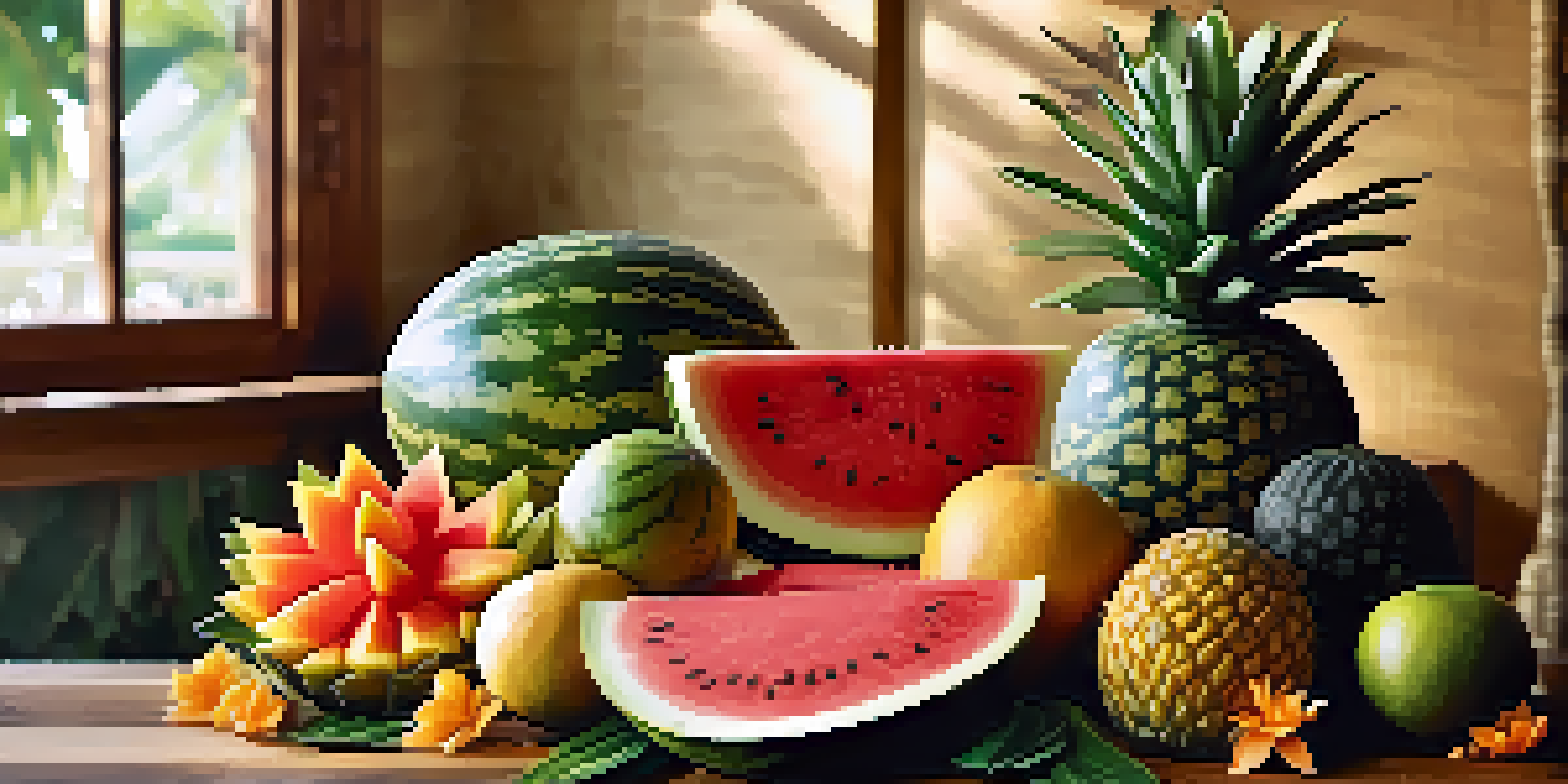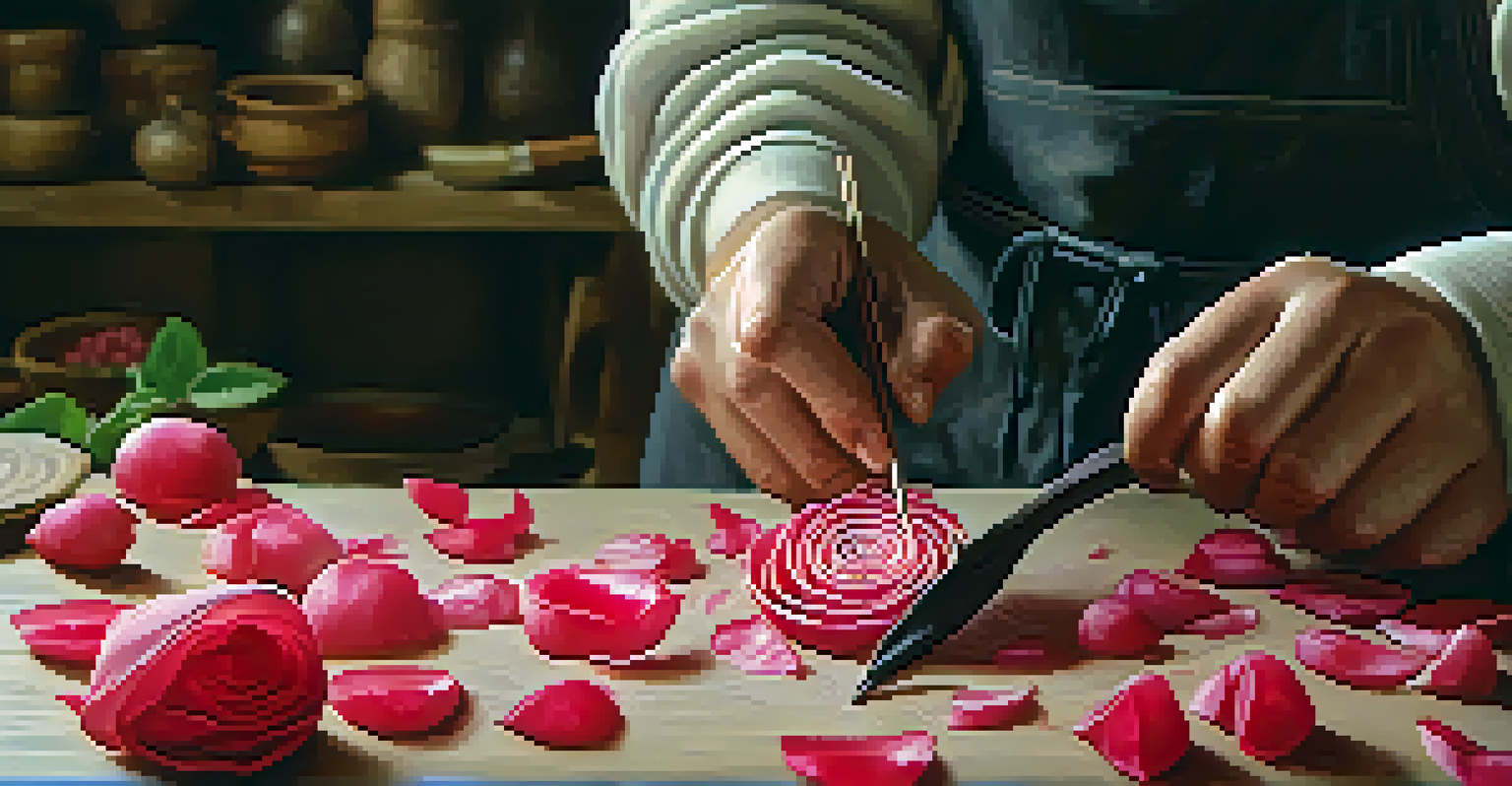Exploring the Cultural Significance of Food Carving Art

Understanding Food Carving: A Brief Overview
Food carving, often referred to as fruit or vegetable carving, is an intricate art form that transforms edible items into stunning visual displays. Originating in various cultures, this practice serves both aesthetic and functional purposes, often used in festivals, ceremonies, and special occasions. At its core, food carving marries creativity with culinary skills, allowing artists to express their cultural heritage through their work.
Food is not just what we eat, but how we present it, and food carving is the ultimate expression of that art.
This art form has a historical significance that varies from culture to culture. For instance, in Thailand, food carving has deep roots in royal cuisine, where elaborate designs were made to impress guests at banquets. Similarly, in many Asian cultures, the presentation of food is considered just as important as the taste, highlighting the importance of visual appeal in dining experiences.
Food carving is not just about decoration; it often carries deeper meanings. For example, specific shapes or designs can symbolize prosperity, health, or happiness, reflecting the values and beliefs of the culture they represent. This connection between food and culture makes food carving a fascinating subject to explore.
Cultural Roots and Historical Significance
Many cultures around the world have embraced food carving, each bringing their unique flair and techniques to the table. In Japan, for example, fruit carving is known as 'Mukimono' and is often seen at traditional celebrations and festivals. Each carve, cut, and design tells a story of its own, deeply tied to Japanese aesthetics and the concept of 'wabi-sabi,' which finds beauty in imperfection.

In Western cultures, food carving is often incorporated into events like weddings and holiday feasts, where elaborate displays of carved melons or pumpkins can steal the show. These creations not only serve as eye-catching centerpieces but also as a way to showcase the skill and creativity of the chef or artist behind them. As such, food carving has evolved into a practice that spans beyond mere decoration.
Cultural Significance of Food Carving
Food carving serves as a cultural storytelling medium, reflecting beliefs and traditions across various societies.
The historical significance of food carving extends to social and religious contexts as well. For instance, in many cultures, certain carvings are created during festivals to honor deities or celebrate harvests, linking the art to community rituals and traditions. Understanding these roots allows us to appreciate food carving as a form of cultural storytelling.
Techniques and Tools Used in Food Carving
The beauty of food carving lies in the techniques and tools artists employ to bring their visions to life. Common tools include sharp knives, specialized carving tools, and, in some cases, even dental instruments for intricate detailing. Mastering these tools is essential for achieving the precision required to create stunning edible art.
The beauty of food carving lies in its ability to transform the ordinary into the extraordinary, connecting cultures and traditions through artistry.
Techniques can vary widely, from simple cuts to elaborate designs that require hours of painstaking work. A novice may start with basic shapes, while seasoned carvers might create elaborate sculptures, like lifelike animals or intricate floral arrangements. Each technique not only enhances the visual appeal but also showcases the carver's skill and patience.
The choice of medium also plays a significant role in food carving. While fruits and vegetables are the most common materials, other edible items like cheese and chocolate can also be transformed into stunning works of art. The versatility in materials allows artists to explore different styles and methods, making food carving a continually evolving art form.
Food Carving in Various Cultures Around the World
Food carving manifests uniquely across different cultures, reflecting local traditions and ingredients. In Thailand, for example, the art of 'Khanom Chan,' or layered dessert carving, showcases vibrant colors and delicate patterns. This not only makes the food visually appealing but also connects the dish to its cultural roots, emphasizing the importance of aesthetics in Thai cuisine.
In Mexico, fruit carving can be seen during festivals and celebrations, where artists create vibrant displays using tropical fruits like papayas and pineapples. These carvings often feature traditional motifs and symbols that resonate with the local community's identity, further enriching the cultural tapestry of the region. Each carving tells a story, linking the present to the past.
Techniques and Tools in Carving
Mastering specific techniques and tools is essential for creating intricate and visually appealing food art.
Similarly, in Western cultures, carving pumpkins during Halloween has become a beloved tradition, with families often competing to create the most unique designs. This practice highlights how food carving can transcend mere artistry to become a communal activity that fosters connection and creativity among people of all ages.
The Role of Food Carving in Modern Culinary Arts
In today's culinary landscape, food carving continues to play a vital role in elevating dining experiences. Chefs and caterers often use food carving to add an artistic flair to their presentations, making dishes more enticing and memorable for guests. This emphasis on aesthetics can significantly enhance the overall dining experience, making it a feast for the eyes as well as the palate.
Social media has further propelled the popularity of food carving, with platforms like Instagram showcasing stunning creations from around the globe. Chefs and food artists share their masterpieces, inspiring others to explore this art form. This visibility has not only elevated the status of food carving but has also encouraged a new generation of artists to experiment with their skills.
Moreover, food carving workshops and classes have gained traction, allowing enthusiasts to learn and practice the craft. These events not only promote the art form but also foster a sense of community among participants, creating a space where cultural traditions and creativity can flourish together.
The Therapeutic Aspects of Food Carving
Engaging in food carving can also have therapeutic benefits, offering a creative outlet for stress relief. The act of carving requires focus and precision, allowing artists to immerse themselves in their work, which can serve as a form of mindfulness practice. This process draws individuals away from everyday distractions, creating a meditative space where they can express themselves artistically.
Many find joy in the tactile nature of food carving—the texture of fruits and vegetables, the vibrant colors, and the satisfaction of transforming something ordinary into a work of art. This hands-on engagement can be incredibly rewarding, fostering a sense of accomplishment and boosting self-esteem as artists develop their skills over time.
Therapeutic Benefits of Carving
Engaging in food carving offers therapeutic benefits, promoting mindfulness and fostering creativity while connecting people.
Additionally, food carving can be a social activity, bringing people together to create and celebrate. Whether in a workshop setting or at home with family and friends, sharing the experience of food carving can strengthen bonds and create lasting memories, further enhancing its therapeutic value.
Preserving the Art of Food Carving for Future Generations
As food carving continues to evolve, it's crucial to preserve the traditional techniques and cultural significance associated with this art form. Many communities are actively working to keep these traditions alive by teaching younger generations the skills and stories behind food carving. This effort ensures that the rich history of food carving is not lost but rather embraced and celebrated.
Educational programs, workshops, and online tutorials are becoming more accessible, allowing enthusiasts of all ages to learn the craft. By sharing knowledge and techniques, experienced carvers can inspire newcomers to explore their creativity and contribute to the ongoing legacy of food carving. This passing down of skills is essential for maintaining cultural identity.

In conclusion, the future of food carving looks bright as artists continue to innovate while honoring traditional practices. By fostering an appreciation for this unique art form, we can ensure that food carving remains a vibrant part of our cultural heritage, encouraging creativity, connection, and celebration around food for generations to come.